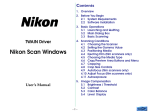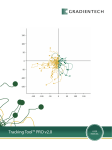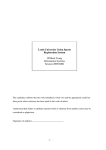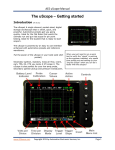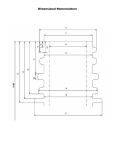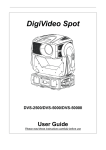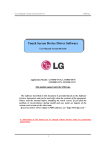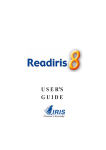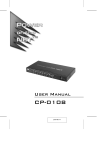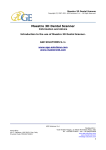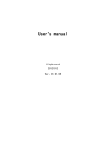Download Nikon Control Windows User`s Manual
Transcript
Contents 1. Overview 2. Before You Begin 2.1 System Requirements 2.2 Software Installation Scanner Control Software Nikon Control Windows 3. Getting Started 3.1 Launching and Quitting 3.2 Control Menu 3.3 File Menu 3.4 Image Menu 3.5 Window Menu 3.6 Control Palette 3.7 Scanning Basics 4. Preferences 4.1 TWAIN source 4.2 Naming Files 4.3 Export Plug-in 4.4 Image Window Handling after Exporting 4.5 Gamma Values 4.6 Control Palette Size 5. Image Acquisition User’s Manual 6. Image Window Operations 6.1 Zoom in/Zoom out 6.2 Rotating the Image 6.3 Scrolling the Image 6.4 Flipping the Image Horizontally 6.5 Flipping the Image Vertically -1- 7. Saving Images 7.1 Save As Window 7.2 Quality Window 7.3 Exporting Images Cautions 8. Loading Images • The information contained in this manual is subject to change without notice. 9. Sequential Image Acquisition 9.1 Sequential Save Window 9.2 Scanning Log 10. About Window Appendix A: Differences between Windows 3.1 and Windows 95 Versions A.1 System Requirements A.2 Software Installation A.3 Control Palette A.4 Control Menu A.5 File Menu A.6 View Menu A.7 Image Menu A.8 Window Menu A.9 Preferences Window A.10 Sequential Save Window A.11 Quality Window A.12 Log Window Index • The reproduction of all or part of this manual without our permission is prohibited. • We have made every effort to produce a perfect manual, but should you find any mistakes, we would be grateful if you would kindly let us know. • We shall take no responsibility for consequences resulting from the operation of this product, despite the terms mentioned above. Trademark Information IBM and IBM PC/AT are registered trademarks of International Business Machines Corporation MS-DOS and MS-Windows are trademarks of Microsoft Corporation. Adobe and Adobe Photoshop are trademarks of Adobe Systems Incorporated. All other brand or product names mentioned in this manual are the trademarks or registered trademarks of their respective holders. -2- Notice concerning prohibition of copying or reproduction • Cautions on certain copies and reproductions The government has issued cautions on copies or reproductions of securities issued by private companies (shares, bills, checks, gift certificates, etc.), commuter passes, or coupon tickets, except when a minimum of necessary copies are to be provided for business use by a company. Also, do not copy or reproduce passports issued by the government, licenses issued by public agencies and private groups, ID cards, and tickets, such as passes and meal coupons. Note that simply being in possession of material which has been copied or reproduced by means of a scanner may be punishable by law. • Items prohibited by law from being copied or reproduced Do not copy or reproduce paper money, coins, securities, government bonds, or local government bonds, even if such copies or reproductions are stamped “Sample”. The copying or reproduction of paper money, coins, or securities which are circulated in a foreign country is prohibited. • Comply with copyright notices The copying or reproduction of works such as books, music, paintings, woodcut prints, maps, drawings, movies, and photographs which are copyrighted creative works is prohibited except when it is done for personal use at home or for similar restricted and non-commercial use. The copying or reproduction of unused postage stamps or post cards issued by the government without obtaining approval from the government is prohibited. The copying or reproduction of stamps issued by the government and certified documents stipulated by law is prohibited. -3- 1. Overview Nikon Control is extremely easy to operate, and offers the following functions. Thank you for purchasing your Nikon scanner. This manual explains how to use Nikon scanners with the Nikon Control Windows application. Please read the documentation thoroughly to ensure proper operation and the best results from your scanner. • Image scanning and display using a TWAIN driver such as Nikon Scan Windows Nikon Control Windows is an application that runs on an IBM PC/AT or compatible computer, and supports scanning and saving image files with Nikon scanners. • Rotation, zoom in/zoom out, scrolling, and vertical or horizontal re-orientation of the displayed image • Opening and display of image files stored on disk • Saving of the displayed image to disk • Automated sequential scanning of a number of images using the optional Nikon SF-100 Auto Slide Feeder mounted on Note for Windows 95 users: The instructions in this manual are the LS-1000 or the optional AF-10 Auto Document Feeder based on the Nikon Control Windows 3.1 version. The dialog boxes mounted on the AX-110 or AX-210 and operation of the Windows 95 version are different from those of the Windows 3.1 version. If you are going to use this product in Important ! the Windows 95 environment, please refer to Appendix A of this manual, which describes differences between the Windows 3.1 and Image sizes that can be handled are shown below. Windows 95 versions. Color images: Horizontal pixels × vertical pixels < 5.3 M Grayscale images: The limits of the image size depend on your monitor setting. 16.7 M colors: (Horizontal pixels × vertical pixels) < 5.3 M 64K colors: (Horizontal pixels × vertical pixels) < 7.9M 32K colors: (Horizontal pixels × vertical pixels) < 8.5 M 256 colors: (Horizontal pixels × vertical pixels) < 15.9M The aspect ratio of images must be less than 256:1 (width : height). -4- 2. Before You Begin 2.2 Software Installation 2.1 System Requirements The Install disk provided with this product contains the Nikon Scan Windows TWAIN driver and the Nikon Control application. To run Nikon Control Windows, the following minimum hardware and software is required: • IBM PC/AT or compatible with i386SX or better • MS-DOS 5.0 or later • MS-Windows 3.1 or later • 8MB or more of RAM (more than 12MB is recommended) (When launching this software as an application’s TWAIN driver, you must take account of the amount of memory used by the application.) • 1MB or more of hard disk capacity (a 300MB or larger hard disk is recommended) • VGA (640 x 480 pixel) monitor or better • Monitor with 16.7M colors, 64K colors, 32K colors, 256 colors, 256 grayscale, 16 grayscale (16.7M colors recommended for color scanning) Check the following before starting installation. • Make sure that you have enough free space on the disk on which you are going to install the software. • Write-protect (lock) the Install disk. • Turn off any applications before starting installation. After checking the above points, begin installation as described below. Step 1 After turning on your computer, launch Windows 3.1 and insert the Install disk into the floppy disk drive. Step 2 Open the Program Manager window. -5- Step 3 Meaning of the buttons Pull down the File menu and choose the Run… command. OK: Executes the command specified in the Command Line box; the Nikon Software Setup window appears. Cancel: Closes the Run window and quits installation. Browse…: Opens the Browse window to let you choose a file from the list, displaying it in the Command Line box. Help: Opens the Program Manager Help window. Step 4 The Run window will appear. If the Install disk is in drive A , enter A:\SETUP.EXE in the Command Line box and click the OK button. The Setup window will then appear during the initialization process. Note: Turn off any applications before starting SETUP.EXE. -6- Step 5 Meaning of the buttons After the initialization process is complete, the Welcome window will appear. Continue: Opens the Nikon Software Setup window. Exit: Quits installation. Help: Opens the Nikon Software Setup Help window shown below. Click OK to return to the Welcome window. -7- Step 6 During installation the progress message window is displayed. Clicking the Continue button in the Welcome window brings up the Nikon Software Setup window. Installation can be stopped by clicking the Cancel button. Clicking the Cancel button brings up the following window. If the specified directory does not exist, a new directory will be created automatically. Meaning of the buttons Continue: Starts the installation. Back: Returns you to the Welcome window shown in Step 5. Help: Opens the Nikon Software Setup Help window shown in Step 5. Clicking Yes stops installation. When the window is opened, the Directory box shows the default drive and directory name where files are to be installed. You can change the drive and directory name by typing in the Directory box. After confirming or typing the drive and directory name, click the Continue button to start installation. -8- Step 7 Step 8 When installation ends successfully, the following window is displayed. Clicking the OK button completes installation. If you want to see the README file, click the Yes button. Clicking the No button skips opening of the README file. Note: The README file may contain information that is not included in this manual. Choose Exit from the File menu to close the README window. Note: For US customers only. After installation is finished, note the addition of the Scsichk.exe file in the directory to which Nikon Control Windows was installed. This utility can help Nikon’s technical support staff diagnose problems with your system, should you experience difficulties. Prior to contacting Nikon Technical support, run the utility to generate a system configuration report, which can either be printed and faxed, or sent via e-mail to Nikon Support staff. -9- 3. Getting Started 3.1 Launching and Quitting Before launching Nikon Control, connect the scanner as described in the hardware manual. First turn on any peripheral devices, including your scanner(s), then turn on the computer. Launching Double-click the Nikon Control icon. After Nikon Control is launched, the following Control palette and menus will appear. Nikon Control is controlled by means of these menus and the Control palette. - 10 - Quitting 3.2 Control Menu To quit Nikon Control, choose Exit from the File menu. The Control menu offers the following functions; Restore: Restores the window to its original size when it has been enlarged with the Maximize command. Move: Lets you move the window. Size: Lets you re-size the window. Minimize: Reduces the window to an icon. Maximize: Enlarges the window to fill the screen. Close: Closes the window. Switch To…: Lets you activate another window. - 11 - TWAIN: 3.3 File Menu This item opens onto the following submenu: Acquire a single image: Performs a scan of one image. This function is identical to that of the Acquire button on the Control palette. Acquire with autofeeder: Performs sequential scan of images. This function is identical to that of the Sequential Acquire button on the Control palette. This function is available only when the optional autofeeder is connected to the scanner. The File menu includes the following items. Open… : Opens an image file on disk and displays it on the monitor. This function is identical to that of the Open button on the Control palette. Close: Closes the display window. The display window is also closed by double-clicking the window’s control box. Save: Saves the displayed image to disk. Save As… : Saves the displayed image to disk under a specified name. This function is identical to that of the Save As button on the Control palette. Export plug-in: Exports a displayed image using Export plugin software which conforms to the Adobe Photoshop Ver 2.0 plug-in specification. Preference…: Used to specify and select the TWAIN driver to be used, and to control the gamma value, file naming procedure for multiple scans, palette size, and export plug in. About…: Shows the About window. Exit: Quits Nikon Control. - 12 - Flip: 3.4 Image Menu This command includes the following subitems: The Image menu includes the following items. Rotate: Horizontal: Flips the image horizontally. This function is identical to that of the Horizontal Flip button on the Control palette. This command has the following sub-items: 90° CW: Rotates the image clockwise, 90 degrees at a time. This function is identical to that of the Rotate button on the Control palette. 90° CCW: Rotates the image counter-clockwise, 90 degrees at a time. 180°: Rotates the image 180 degrees at a time. - 13 - Vertical: Flips the image vertically. This function is identical to that of the Vertical Flip button on the Control palette. If you pull down the menu after acquiring images, you will see that the names of the images have been added at the end of the menu. 3.5 Window Menu Cascade: Arranges multiple image windows so they overlap. Tile: Arranges all open images in windows that do not overlap on the screen. Arrange Icon: Arranges image icons in the window. Close All: Closes all open image windows. Zoom In: Zooms in the view of an active image window. This function can also be performed by clicking the Zoom button on the Control palette. Zoom Out: Zooms out the view of an active image window. This function can also be performed by clicking the Zoom button on the Control palette while holding down the Ctrl key. - 14 - 3.6 Control Palette Buttons Acquire: Performs a scan of one image, using the currently selected TWAIN driver. This function is identical to that of Acquire a single image… in the File menu. When Nikon Control is first launched after installation, the following Control palette appears. There are two palette sizes that can be displayed. The Large palette is shown below. Sequential Acquire: Performs sequential scanning of a number of images, using the currently selected TWAIN driver. This function is identical to that of Acquire with autofeeder… in the File menu. This function is available only when the autofeeder is connected to the scanner. Export: Exports a displayed image using export plug-ins which conform to the Adobe Photoshop Ver 2.0 plug-in specification. This function is identical to that of Export plug-in in the File menu. Open: Opens an image file on disk and displays it on the monitor. This function is identical to that of Open… in the File menu. Save As: Saves the displayed image to disk. This function is identical to that of Save As… in the File menu. - 15 - Tool Buttons Help Message Five tools are provided to perform zoom in/zoom out, rotation, scrolling, and vertical or horizontal flip of the image. In the large palette, you can see interactive help messages. Positioning the mouse cursor on a button will display a Help message in the message display area. Zoom-in: An image can be zoomed in by clicking this button, then clicking the mouse button inside the image window. This function is identical to that of Zoom In in the Window menu. Zoom-out: An image can be zoomed out by clicking this button while holding down the Ctrl key, then clicking the mouse button inside the image window. This function is identical to that of Zoom Out in the Window menu. Rotate: Clicking this button rotates the image clockwise, 90 degrees at a time. This function is identical to that of 90˚ CW in the Rotate submenu in the Im age menu. Scroll: The image is scrolled by clicking this button, then dragging the mouse inside the display window while holding down the mouse button. Horizontal Flip: Clicking this button flips the image horizontally. This function is identical to that of Horizontal in the Flip submenu in the Im age menu. Vertical Flip: Clicking this button flips the image vertically. This function is identical to Vertical in the Im age menu’s Flip submenu. - 16 - 3.7 Scanning Basics Step 1 Basic operating procedure for Nikon Control is as follows. Specify the TWAIN driver to be used by Nikon Control. To specify the TWAIN driver, choose Preference… from the File menu. Step 1 Setup Select preferences, such as the TWAIN driver to be used. Step 2 Scan and display an image. Note: For sequential scanning, see Chapter 9. To load an image from disk, see Chapter 8. Step 3 Save the displayed image to disk. Step 4 Quit, or repeat the procedure from Step 2 above. This section describes a simple procedure for scanning a single image and saving it to disk. - 17 - The Nikon Control Preferences window appears. Select the required TWAIN driver from the TWAIN Source pop-up menu. Step 2 Click the Acquire button on the Control palette, or choose Acquire a single image from the File menu. Acquire button - 18 - If Nikon Scan has been selected, the following window will appear. When the TWAIN driver is used to acquire an image, the acquired image appears in a window. (See the manual supplied with the TWAIN driver for the acquisition procedure.) Note: The above window may differ depending on the scanner used. The image in the display window can be zoomed in/zoomed out, rotated, scrolled, or flipped vertically or horizontally by means of the five tools on the Control palette. - 19 - Step 3 The Save as window shown below will appear. Save the acquired image to disk. To save an image to disk, either click the Save As button on the Control palette or choose Save As… from the File menu. Save As button Specify the drive and directory in which the image is to be saved, enter the file name, specify the file type, and click the OK button. The image is then saved. The file type can be selected from the pop-up menu. The file types that can be specified are shown below. If JPEG (*.JPG) is selected as the file type, the Quality… button is enabled, and the compression quality (and resulting file size) can be changed. If any other file type is selected, the Quality… button is dimmed and disabled. When the Quality… button is clicked, the Quality window is displayed. For details concerning the Quality window, see Section 7.2. - 20 - Preferences window operations are described below. 4. Preferences First, choose Preference… from the File menu. The Preferences window allows the user to specify settings for general control of scan operations. The following settings are possible. • Select the TWAIN driver to be used for image acquisition. • Set the position of the serial number (as a prefix or suffix) in the file name when sequential image acquisition is carried out. • Select the Export plug-in to be used for image export. • Decide whether the displayed images are to be closed or not after exporting the images. • Set the gamma value of input images. • Set the gamma value of the monitor being used. • Select the palette size to be displayed. Selections made in the Preferences window are saved after exiting the window. The settings are recalled every time Nikon Control is launched. - 21 - The Nikon Control Preferences window appears. Description of items in the Preferences window TWAIN source: A pop-up menu lets you locate the TWAIN driver you wish to use. Sequential file number: Either of the buttons is selected to specify whether the numerical portion of the file name is to be appended before or after the fixed part of the file name, when performing continuous image acquisition. Export plug-in: A pop-up menu lets you locate Export plugins which conform to Adobe Photoshop Ver 2.0 plug-in specifications. Image window handling after exporting: Either of the buttons is selected to specify whether the original scanned images are to be closed or not after exporting the images. Gamma Value: Allows you to set the Gamma value of the monitor being used. Control palette: Either of the radio buttons is selected to specify whether a Large or Small Control palette is used. Cancel: Changes are discarded and the Preferences window is closed. OK: Changes are saved and the Preferences window is closed. - 22 - 4.1 TWAIN source 4.2 Naming Files If you want to change to another TWAIN driver, pull down the TWAIN source menu and choose the required TWAIN driver from the menu. The TWAIN driver is then selected and the newly selected TWAIN driver is displayed in the box. The names of individual files saved by means of sequential image scanning consist of a fixed part and a serial number. This setting specifies whether the number is to be placed before or after the fixed part. The fixed part of the file name is specified in the Sequential save window as a “Prefix name” or “Suffix name” when the image files are saved. For example, if the As a suffix button is selected here, and the fixed part “Image” is specified in the Sequential save window, the file names, in the order saved, will be “Image001”, “Image002”, “Image003” and so on. Naming Procedure Choices As a prefix: The serial number precedes the fixed part. As a suffix: The serial number follows the fixed part. - 23 - 4.3 Export Plug-in If you want to change to another Export plug-in, pull down the Export plug-in menu and choose the required Export plug-in which conforms to the Adobe Photoshop Ver 2.0 specification. The Export plug-in is then selected and the newly selected Export plug-in is displayed in the box. Note: Some Export plug-ins which conform to the Adobe Photoshop Ver 2.0 plug-in specification might not be supported. 4.4 Image Window Handling after Exporting The original scanned images can be automatically closed after exporting the images. Either of the buttons is selected to specify whether the displayed images are to be closed or not after exporting the images. Meaning of the Buttons Close: The original scanned images are automatically closed after exporting. Hold: The original scanned images are held on the monitor. - 24 - Clicking the Config… button brings up the Monitor Gamma window shown below. 4.5 Gamma Values Enter the Gamma values of the image. Acceptable values range from 0.80 to 3.00. The default setting is 1.80. Change the display resolution to 640 x 480 and set the gamma value while viewing the chart. The chart display shows a halftone gray patch made of black and white dots, and a midtone gray value calculated from the current monitor gamma value. Try various monitor gamma values until the mid-tone gray value and the halftone gray match as closely as possible. The gamma value is now set. Acceptable values range from 0.80 to 3.00. The default setting is 1.80. Meaning of the Buttons OK: Cancel: - 25 - Save changes and return to Preferences window. Discard changes and return to Preferences window. 4.6 Control Palette Size The Nikon Control has two sizes of Control palette. You can select the palette size by clicking the appropriate button. Meaning of the Buttons Small Palette: The small control palette is displayed. Large Palette: The large control palette is displayed. Large Control Palette Sm all Control Palette Note: The default setting is “Large Palette”. - 26 - 5. Image Acquisition To acquire images one-by-one, click the Acquire button on the Control palette or choose Acquire a single image from the File menu. The TWAIN driver specified in the Preferences window is launched, and the operating window for that driver appears. If Nikon Scan (the Nikon TWAIN source) has been selected, the following window will appear. See the instruction manual of the selected TWAIN driver for set up details. Acquire button Note: The above dialog box is for the LS-1000 film scanner. The corresponding window for other scanners may be different. - 27 - After a preview is made and cropped, setting adjusted, and the Scan button is clicked, the scanned image is displayed in a window. - 28 - 6.2 Rotating the Image 6. Image Window Operations Clicking the Rotate button rotates the image in the active window clockwise, 90 degrees at a time. When an image is displayed, the image can be magnified or reduced, rotated, scrolled, or flipped vertically or horizontally by means of five tools or the Im age and Window menus. 6.1 Zoom in/Zoom out When the Zoom button is clicked, the mouse cursor changes to the shape of a magnifying glass. Clicking the magnifying cursor anywhere within the image display window will then zoom in the image. To zoom out the image, click the mouse button inside the display window while holding down the Ctrl key. Zoom-in cursor Zoom-out cursor This function can be performed by choosing Zoom In or Zoom Out from the Window menu. Rotating can be performed by choosing Rotate from the Im age menu. Meaning of the Items 90° CW: Rotates the image clockwise, 90 degrees at a time. 90° CCW: Rotates the image counter-clockwise, 90 degrees at a time. 180° : Rotates the image 180 degrees at a time. - 29 - 6.3 Scrolling the Image 6.4 Flipping the Image Horizontally The Hand tool can be used to pan or scroll the image if it is too large to be completely displayed within the window. Clicking the Horizontal Flip button flips the image in the active window horizontally. When the Scroll button is clicked, the cursor changes to the shape of a hand. The image can now be scrolled by dragging inside the display window with the mouse button held down. Flipping can also be performed by choosing Horizontal from the Flip submenu. Scroll slider Arrow button The image can also be scrolled by dragging the display window’s scroll slider or clicking the arrow buttons at either end of the scroll bars. - 30 - 6.5 Flipping the Image Vertically Clicking the Vertical Flip button flips the image in the active window vertically. Flipping can also be performed by choosing Vertical from the Flip submenu. - 31 - 7. Saving Images The image displayed in the display window is saved using the Save as window which appears when you click the Save As button on the Control palette or choose Save As… from the File menu. If the acquired image has not yet been saved, and you attempt to close the image window by choosing Close from the File menu or double-clicking the image window’s control box, an alert message window will appear, and you should then click the appropriate button. Save As button - 32 - Meaning of Items in Save as window 7.1 Save As Window When the Save window appears, specify the drive and directory in which the image is to be saved, the file name, and the file type, then click the Save button. Drives: Assigns a drive to save an image. Directories: Assigns a directory to save an image. List Files of Type: JPEG (*.JPG), BITMAP (*.BMP), or TIFF (*.TIF) can be selected as the file type from the popup menu. The file type selected here is saved, and is then recalled the next time the window is opened. Quality…: If JPEG (*.JPG) is selected as the file type, the Quality… button is enabled, and the compression quality (and resulting file size) can be changed. If any other file type is selected, the Quality… button is dimmed and disabled. When the Quality… button is clicked, the Quality window is displayed. For details concerning the Quality window, see Section 7.2. Cancel: Changes are discarded and the Save as window is closed. OK: The image is saved. - 33 - 7.2 Quality Window 7.3 Exporting Images If JPEG (*.JPG) is selected as the file type in the Save as window and the Quality… button is clicked, the Select JPEG Image Quality window appears. Scanned images can be exported using an Export plug-in. You can specify the Export plug-in in the Preferences window. To specify the Export plug-in, see Section 4.3. To export a scanned image, click the Export button on the Control palette, or choose Export plug-in from the File menu. Export button The compression setting value can be set by dragging the slider with the mouse. (Dragging the slider changes the displayed number.) Moving the slider to the right decreases compression and increases the image quality; moving the slider to the left has the opposite effect. Permissible values range from 0 to 100. Note: “Dragging” means to hold down the mouse button while moving the mouse. For information on the selected Export plug-in, please refer to the plug-in's software manual. Meaning of Buttons Cancel: Changes are discarded and the Quality window is closed. OK: The value is saved and the Quality window is closed. - 34 - When either operation is performed, the Open window appears. 8. Loading Images An image file saved to disk is loaded using the Open window which appears when you click the Open button on the Control palette or choose Open… from the File menu. Open button When the drive, directory, and file name are specified, the image is read and displayed in the display window. Meaning of Items in the Open Window Drives: Assigns a drive to load an image. Directories: Assigns a directory to load an image. Cancel: Cancels operation and closes the Open window. OK: Opens the selected image. - 35 - 9. Sequential Image Acquisition 9.1 Sequential Save Window With the optional SF-100 Auto Slide Feeder mounted on the Nikon LS-1000 or optional AF-10 Auto Document Feeder mounted on the AX-110 or AX-210, images can be acquired sequentially, completely unattended. When either operation is performed, the Sequential save window appears. Sequential acquisition is started by clicking the Sequential Acquire button on the Control palette or choosing Acquire with autofeeder from the File menu. Sequential Acquire button When the OK button on the Sequential save window is clicked after specifying the drive and directory in which the images are to be saved, the file name, file type, and the number of scans, sequential scan operation is started. - 36 - Meaning of Items in the Sequential save window Quality…: Drives: Assigns a drive to save images. Directories: Assigns a directory to save images. List Files of Type: If JPEG (*.JPG) is selected as the file type, the Quality… button is enabled, and the compression quality (and resulting file size) can be changed. If any other file type is selected, the Quality… button is dimmed and disabled. When the Quality… button is clicked the Quality window is displayed. For details concerning the Quality dialog box, see Section 7.2. JPEG (*.JPG), BITMAP (*.BMP), or TIFF (*.TIF) can be selected as the file type from the popup menu. The file type selected here is saved, and is recalled when this window is next opened. Number of sequential scans: Specifies the number of images to be scanned. If Scan all images in autofeeder is selected, all the documents in the autofeeder will be scanned. If a number is set in the box, that number of images will be scanned. Prefix name (Suffix name): The name of each file saved during sequential image scanning consists of a fixed part and a serial number. The fixed part of the name is typed in this box. For example, if the As a suffix button is selected in the Preference Cancel: Changes are discarded and the Sequential window, and the fixed part “Image” is save window is closed. specified in the Sequential Scan dialog box, OK: Sequential acquisition is started in accordance the file names will be, in the order saved, with the settings. “Image001”, “Image002”, “Image003”, and so on. See Section 4.3 for a description of how to indicate whether the number is to precede or follow the fixed part of the file name. - 37 - If a file already exists with the file name specified here, a message window will be displayed. You should then take appropriate action as indicated by the message. When the OK button is clicked on the Sequential save window, sequential scan operation is started. The TWAIN driver specified in the Preferences window is launched, and the operating window for that software appears. If the Nikon TWAIN Source (Nikon Scan) has been selected, the following window will appear. See the instruction manual of the selected TWAIN driver for set up details. Note: The above window is for the LS-1000 film scanner. The corresponding window for other scanners may be different. - 38 - When the Log window is closed on completion of the sequential scan operation, the following window is displayed. 9.2 Scanning Log When sequential scanning begins, the Log window appears and processing results are displayed image by image. When you return after an unattended scanning session, consult the log first to get immediate feedback on scan completion. The contents of the Log window can be saved as a text file, and can be opened later using a text editor such as NotePad. Specify the drive and directory in which the log file is to be saved, the file name, and file type, and click the OK button to save the log file. - 39 - 10. About Window When About… is chosen from the File menu, the About window appears. The About window disappears the OK button is clicked. - 40 - A.2 Software Installation Appendix A: Differences between Windows 3.1 and Windows 95 Versions Step 1 After turning on your computer, start Windows 95 and insert the Install disk into the floppy disk drive. Step 2 A.1 System Requirements Click the Start button. To run the Nikon Control Windows 95 version, the following minimum hardware and software is required: • IBM PC/AT or compatible with i386DX or better • Windows 95 • 8MB or more of RAM (When launching this software as an application’s TWAIN driver, you must take account of the amount of memory used by the application.) • 1MB or more of hard disk capacity (a 300MB or larger hard disk is recommended) • VGA (640 x 480) monitor or better • 8-bit or more of video card and monitor with 16.7M colors, 64K colors, 32K colors, 256 colors - 41 - Step 3 Open the Control Panel from the Settings menu and doubleclick “Add/Remove Programs”. Windows will prompt you to insert the installation disk into an appropriate drive. Make sure that the Install disk is inserted in the floppy disk drive and then click Next. The following window will appear. Step 4 Go to the Install/Unistall tab and click Install…. - 42 - Step 5 In the Comm and line text box, enter the floppy disk drive’s drive letter followed by “\SETUP.EXE” (if the floppy-disk drive is drive “A:”, for example, enter “A:\SETUP.EXE”) and then click Finish. The Welcome window will then appear. After the Welcome window is closed, the following window appears to show the amount of Free and Required disk space. Clicking the Continue button starts installation. The procedure from here on is the same as for the Windows 3.1 version. See Section 2.2. - 43 - A.3 Control Palette A.4 Control Menu The control palette for the Windows 95 version is shown below. The Control menu of the Windows 95 version is shown below. • The Switch To… item is omitted from the Control menu. Status bar • The Export plug-in button is omitted from the Control palette. • Help messages are displayed on the Status bar of the Main Window. - 44 - • The Print Setup… and the Print… commands are added on the File menu. A.5 File Menu The File menu of the Windows 95 version is shown below. Using these commands, grayscale and color images can be printed on the printer you are using. Choose the Print Setup… command to set up the printer and the Print… command to print images. Since the operation of these commands depends on the printer driver you are using, refer to the individual printer driver documentation for information on operation. • The Export plug-in command is omitted from the File menu. • The names of image files recently acquired or opened are shown at the bottom of the File menu. You can open the image directly by choosing the file names without using the Open command. Note: If the printer and image resolutions are not the same, the actual printed image size will be different from the original image size. For example, when a 5˝x 5˝ image acquired at 600dpi is printed on a 300dpi printer, a 10˝ x 10˝ sized image is printed. In this case, part of the image may not be printed on letter size paper. To print the entire image on letter size paper, you should change the printer resolution if possible, or else change the image resolution by using the Resolution command from the Image menu (see Section A.7). Note: When printing on a color printer, the printed size may often be larger than the original image size, even if the image has the same resolution as the printer. We recommend setting an image resolution lower than the printer resolution when printing an image on a color printer. - 45 - A.6 View Menu Status Bar The View menu of the Windows 95 version is shown below. The View menu has the following items. When the Status Bar item is checked, the Status bar appears at the bottom of Nikon Control Main window. Help messages are shown in the Status bar. The Zoom In and Zoom Out commands are added to the View menu. These commands are omitted from the Window menu. Control Palette Nikon Control has two sizes of Control window. You can select the palette size by choosing the appropriate item. Large control window: Selects the large control palette. Small control window: Selects the small control palette. Large control window Small control window - 46 - Status bar Choosing the Resolution command brings up the Resolution window. The Resolution window shows the size and the resolution of the active window image. A.7 Image Menu The Image menu of the Windows 95 version is shown below. The Information and the Resolution commands are added to the Image menu. These commands provide or change information on the images. Choosing the Information command brings up the Information window. This window shows information about the active image. The width/height aspect is locked. If either width or height is entered, the other value is automatically calculated to maintain the locked width/height aspect, and the new value is displayed. The units for width and height can be selected from the pop-up menu. When this selection is changed, the values in the boxes are converted to the equivalent new units. - 47 - Entering a new value in the resolution box changes the image resolution. Using this function, you can print images on your printer in any size you want. A.8 Window Menu The unit for resolution can be selected from the pop-up menu. When this selection is changed, the values in the boxes are converted to the equivalent new units. The Window menu of the Windows 95 version is shown below. The Zoom In and Zoom Out commands are omitted from the Window menu. - 48 - The “Display information on title bar” item is added to the Preferences window. The magnification and/or pixel dimensions of an image can be added to the image window’s title bar. A.9 Preferences Window The Preferences window of the Windows 95 version is shown below. Meaning of the Radio Buttons Magnification: The current magnification, or zoom level, of an image is displayed in its title bar when this button is pressed. Size (pixels): The pixel dimensions of an image are displayed in its title bar when this button is pressed. Both Magnification and Size: The current magnification and pixel dimensions of an image are displayed in its title bar when this button is pressed. The following items are omitted from the Preferences window: When Both Magnification and Size is selected, the image window’s title bar will appear as shown below. • The Export plug-in selection menu Title bar • Image window handling after exporting • Control window selection (moved to the View menu) - 49 - A.10 Sequential Save Window The Sequential Save window of the Windows 95 version is shown below. The Sequential Save window appears when the Sequential Acquisition button on the Control palette is clicked or the Acquire with Autofeeder command is chosen from the File menu. The Starting box specifies the initial file name number. For example, if the file name “ScanImage” is specified and the number “5” is typed in this box, the file names will be, in the order saved, “ScanImage005”, “ScanImage006”, “ScanImage007”, and so on. The “Starting” box is added to the Sequential Save window. - 50 - A.11 Quality Window A.12 Log Window The Quality window of the Windows 95 version is shown below. The Quality window appears when JPEG (*.JPG) is selected as the file type in the Save or Sequential Save window, and the Quality… button is clicked. The time and date are included in the Log window of the Windows 95 version. The compression setting value can be set by entering a value in the box or dragging the slider with the mouse. Moving the slider to the right decreases the compression and increases the image quality; moving the slider to the left has the opposite effect. Permissible values range from 0 to 100. The preview area shows a part of the image. Clicking the + / button enlarges/reduces the magnitude of the preview. - 51 - Index A E L R About command 12, 40 About window 40 Acquire a Single Image command 12, 18, 27 Acquire button 15, 18, 27 Acquire with Autofeeder command 12, 36 AF-10 auto document feeder 4, 36 Arrange Icon command 14 As a prefix 23 As a suffix 23 Auto slide feeder 4, 36 AX-110 4, 36 AX-210 4, 36 Enlarging and reducing images 29 Exit command 12 Export button 15, 34 Export plug-in 22, 24 Export plug-in command 12, 34 Exporting images 34 Launching 10 List Files of Type text box 33, 37 Loading images 35 LS-1000 4, 36 README file 9 Resolution 47 Rotate button 16, 29 Rotate command 13, 29 Rotating images 29 N S Naming files 23 Nikon Control icon 10 Number of sequential scans 37 Save As button 15, 20, 32 Save As command 12, 20, 32 Save As window 33 Save command 12 Saving images 32 Scanning basics 17 Scanning log 39 Scroll button 16, 30 Scrolling images 30 Scsichk.exe file 9 Sequential Acquire button 15, 36 Sequential file number 22 Sequential image acquisition 36 Sequential save window 36 Windows 95 50 SF-100. See Auto slide feeder Status bar 46 Suffix name 37 System requirements 5 Windows 95 41 C Cascade command 14 Close All command 14 Close command 12, 32 Config… button 25 Control menu 11 Windows 95 44 Control palette 15 large 26, 46 setting size of 26 Windows 95 46 small 26, 46 Windows 95 44 F File menu 12 Windows 95 45 Flip horizontal 30 vertical 31 Flip command 13 O Open button 15, 35 Open command 12, 35 P G Preference… command 12, 17, 21 Preferences 21 Preferences window 18, 22 Windows 95 49 Prefix name 37 Gamma value 22, 25 H Help 16 Horizontal command 13, 30 Horizontal Flip button 16, 30 Q I Image acquisition 27 Image menu 13 Windows 95 47–48 Image window handling after exporting 22, 24 Image window operations 29 Installation 5 Windows 95 41 Quality window 34 Windows 95 51 Quality… button 33 Quitting 11 - 52 - T Tile command 14 Tool buttons 16 TWAIN command 12 TWAIN source 22, 23 TWAIN source pop-up menu 18, 23 V Vertical command 31 Vertical Flip button 16, 31 W Window menu 14 Windows 95 48 Windows 95 4, 41–51 Z Zoom button 16 Zoom cursors 29 Zoom In command 14, 29 Zoom Out command 14, 29 - 53 -





















































